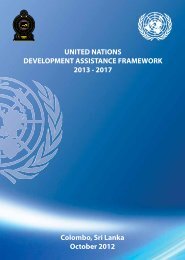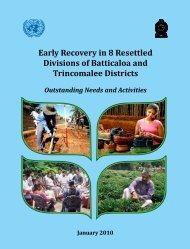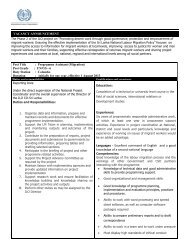Sri Lanka Human Development Report 2012.pdf
Sri Lanka Human Development Report 2012.pdf
Sri Lanka Human Development Report 2012.pdf
You also want an ePaper? Increase the reach of your titles
YUMPU automatically turns print PDFs into web optimized ePapers that Google loves.
CHAPTER<br />
4<br />
Bridging<br />
<strong>Human</strong> <strong>Development</strong> Gaps: Education<br />
By helping people achieve their competencies, education<br />
expands the space for human development. 123 Countries<br />
that do well in education do well in terms of human<br />
development: According to the OECD’s comprehensive<br />
world education ranking for the year 2009, 124 the 5 topperforming<br />
countries in education-Canada, Finland,<br />
Japan, New Zealand and the Republic of Korea-are among<br />
the 17 countries with the highest human development<br />
achievements. 125 Education also moulds a country’s social,<br />
cultural and political developments, and in multi-ethnic<br />
societies can build trust and bring diverse people together<br />
to work for common goals. 126<br />
The intrinsic value of education is coupled with its<br />
instrumental and transitional values: enlarging the<br />
national pie, powering upward socioeconomic and<br />
political mobility, shattering gender-related barriers,<br />
positively influencing the use of health services, and<br />
bettering knowledge on child nutrition, etc. 127<br />
In the modern global economy, needed competencies and<br />
capabilities are constantly changing, marked by overall<br />
increased demand for ‘expert-thinking’ 128 and ‘complexcommunication’.<br />
129 Building these skills starts with a<br />
solid foundation of reading, writing, mathematics, and<br />
the sciences, including technology, but also depends on<br />
opportunities for more sophisticated learning, education<br />
and research.<br />
Education for <strong>Human</strong> <strong>Development</strong><br />
<strong>Sri</strong> <strong>Lanka</strong>’s education attainment levels are high, if judged<br />
by basic indicators such as literacy, access to primary<br />
education and education completion rates. Adult literacy<br />
reached 91 percent in 2008, 130 and <strong>Sri</strong> <strong>Lanka</strong> has almost<br />
achieved the MDG targets for universal primary education<br />
and gender equity in education. In 2006, it attained a<br />
primary enrolment rate of 97.5 percent, and practically<br />
reached gender parity in primary education, with the<br />
ratio of girls to boys at 99 percent. 131 Despite being a<br />
lower middle-income country, <strong>Sri</strong> <strong>Lanka</strong> is often cited as a<br />
nation with high educational achievements.<br />
New challenges have come in providing quality education<br />
that is relevant to a modern economy and the lifestyles of<br />
<strong>Sri</strong> <strong>Lanka</strong>ns today. Shortages of certain kinds of skills may<br />
only grow as the country moves towards a knowledgebased<br />
economy. This needs to be redressed quickly to<br />
preserve competitive advantages and reduce the tendency<br />
of very skilled people to leave the country.<br />
Like all developing nations, <strong>Sri</strong> <strong>Lanka</strong> will have to improve<br />
the quality and relevance of tertiary education, and prepare<br />
workers with the advanced skills sets that a competitive<br />
economy demands. Present government development<br />
policy aims to reposition <strong>Sri</strong> <strong>Lanka</strong> in the global arena as a<br />
middle-income country with a strong knowledge base and<br />
improved living standards. The government development<br />
policy framework, ‘Mahinda Chintana—Vision for the<br />
Future’, has identified five focus areas: naval, aviation,<br />
commerce, energy and knowledge. 132<br />
A principal issue, however, is the need to bridge the<br />
mismatch between skills acquired through the education<br />
system and the requirements of the labour market. 133 A<br />
2003 sector review by the National Education Commission<br />
found that the system has failed to enhance the quality<br />
and relevance of education, and thus to prepare people<br />
adequately for work. 134 This chapter examines <strong>Sri</strong> <strong>Lanka</strong>’s<br />
successes and limitations in meeting these challenges.<br />
Delivery of Education Services<br />
The general education system provides 13 years in three<br />
cycles: primary (grades 1-5), junior secondary (grades 6-<br />
9), senior secondary (grades 10-11), and collegiate (grades<br />
12-13). All children aged 5 to 14 must complete the<br />
primary and junior secondary education cycles. 135 Two<br />
national level examinations—the General Certificates<br />
of Education Ordinary (O-Levels) and Advanced (A-<br />
sri lanka <strong>Human</strong> <strong>Development</strong> report 2012 59






